Wku pathophysiology - Study guides, Class notes & Summaries
Looking for the best study guides, study notes and summaries about Wku pathophysiology? On this page you'll find 37 study documents about Wku pathophysiology.
All 37 results
Sort by
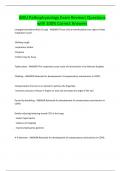
-
WKU Pathophysiology Exam Review| Questions with 100% Correct Answers
- Exam (elaborations) • 26 pages • 2024
- Available in package deal
-
- $13.19
- + learn more
Laryngotracheobronchitis (Croup) - ANSWER These clinical manifestations are signs of what respiratory issue? -Barking cough -inspiratory stridor -Dyspnea -Patient may be fussy Tuberculosis - ANSWER This respiratory issue route of transmission is by Airborne droplets Clubbing - ANSWER Rationale for development of compensatory mechanisms in COPD: Compensation that occurs in atempt to perfuse the fingertips -increases amount of tissue in fingers or toes and increases the angle of the nail ...
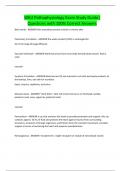
-
WKU Pathophysiology Exam Study Guide| Questions with 100% Correct Answers
- Exam (elaborations) • 24 pages • 2024
- Available in package deal
-
- $13.19
- + learn more
Birth marks - ANSWER Skin anomalies present at birth or shortly after Pulmonary Circulation - ANSWER the waste product (CO2) is exchanged for O2 in the lungs through diffusion. Vascular birthmark - ANSWER Mark that arises from incorrectly formed blood vessels. Red in color vascular Systemic Circulation - ANSWER blood carries O2 and nutrients to all cells and waste products to the kidneys, liver, and skin for excretion. heart, arteries, capillaries, and veins.
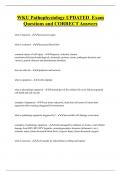
-
WKU Pathophysiology UPDATED Exam Questions and CORRECT Answers
- Exam (elaborations) • 15 pages • 2024
- Available in package deal
-
- $8.99
- + learn more
what is hypoxia - decreased oxygen what is ischemia - decreased blood flow common causes of cell injury - hypoxia, ischemia, trauma (mechanical/electrical/radiological), chemicals, poisons, toxins, pathogens (bacteria and viruses), genetic diseases and autoimmune disorders how do cells die - apoptosis and necrosis what is apoptosis - cells implode what is physiologic apoptosis - normal part of the cellular life cycle AKA programed cell death and cell suicide

-
WKU Pathophysiology Exam -Endocrine| Questions with 100% Correct Answers
- Exam (elaborations) • 16 pages • 2024
-
- $12.99
- + learn more
Hypopituitarism - ANSWER insufficient amount of some or all pituitary hormones panhypopituitarism - ANSWER total pituitary impairment that brings about a progressive and general loss of hormone activity pan - ANSWER all; not seen a lot unless seen with a tumor or autoimmune disorder diseases of hypopituitarism? - ANSWER pituitary dwarfism and diabetes insipidus most common kind of dwarfism that is not a pituitary problem? - ANSWER achondroplasia What causes pituitary dwarfism? - ANSWER to ...
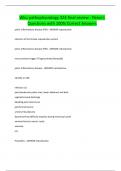
-
Wku pathophysiology 324 final review - flener| Questions with 100% Correct Answers
- Exam (elaborations) • 18 pages • 2024
- Available in package deal
-
- $12.99
- + learn more
pelvic inflammatory disease (PID) - ANSWER reproductive infection of the female reproductive system pelvic inflammatory disease (PID) - ANSWER reproductive most common trigger STI (gonorrhea/chlamydia) pelvic inflammatory disease - ANSWER reproductive identify on CM:

-
WKU Pathophysiology Cellular Certification Exam Questions and CORRECT Answers
- Exam (elaborations) • 15 pages • 2024
- Available in package deal
-
- $8.99
- + learn more
what is hypoxia - decreased oxygen what is ischemia - decreased blood flow common causes of cell injury - hypoxia, ischemia, trauma (mechanical/electrical/radiological), chemicals, poisons, toxins, pathogens (bacteria and viruses), genetic diseases and autoimmune disorders how do cells die - apoptosis and necrosis what is apoptosis - cells implode what is physiologic apoptosis - normal part of the cellular life cycle AKA programed cell death and cell suicide
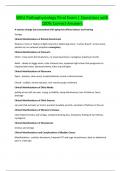
-
WKU Pathophysiology Final Exam | Questions with 100% Correct Answers
- Exam (elaborations) • 15 pages • 2024
- Available in package deal
-
- $12.99
- + learn more
A sensory change (ear) associated with aging that affects balance and hearing Vertigo Clinical Manifestations of Retinal Detachment floaties or lines or flashes of light, blurred or darkening vision, "curtain drawn" across vision, painless w/ no outward symptoms emergency Clinical Manifestations of Cataracts Infant - hazy vision d/t cloudy lens, no visual awareness, nystagmus (rapid eye mvmt) Adult - cloudy or foggy vision, color intensity loss, impaired night vision that progresses to ...
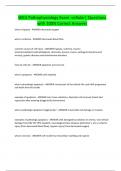
-
WKU Pathophysiology Exam -cellular| Questions with 100% Correct Answer
- Exam (elaborations) • 16 pages • 2024
-
- $12.99
- + learn more
what is hypoxia - ANSWER decreased oxygen what is ischemia - ANSWER decreased blood flow common causes of cell injury - ANSWER hypoxia, ischemia, trauma (mechanical/electrical/radiological), chemicals, poisons, toxins, pathogens (bacteria and viruses), genetic diseases and autoimmune disorders
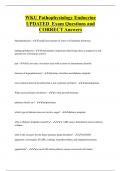
-
WKU Pathophysiology Endocrine UPDATED Exam Questions and CORRECT Answers
- Exam (elaborations) • 15 pages • 2024
- Available in package deal
-
- $8.99
- + learn more
Hypopituitarism - insufficient amount of some or all pituitary hormones panhypopituitarism - total pituitary impairment that brings about a progressive and general loss of hormone activity pan - all; not seen a lot unless seen with a tumor or autoimmune disorder diseases of hypopituitarism? - pituitary dwarfism and diabetes insipidus most common kind of dwarfism that is not a pituitary problem? - achondroplasia What causes pituitary dwarfism? - to little growth hormone pituitary dwarfs a...

-
WKU Pathophysiology Immunity UPDATED Exam Questions and CORRECT Answers
- Exam (elaborations) • 11 pages • 2024
- Available in package deal
-
- $8.49
- + learn more
are nonspecific defense mechanisms innate or acquired? - innate are specific defense mechanisms innate or acquired? - acquired what lines of defense are nonspecific defense mechanisms - first and second what lines of defense are specific defense mechanisms - third what are examples of first line of defense - skin, mucous membranes, secretions of skin and mucous membranes what are examples of second line of defense - phagocytic white blood cells, antimicrobial proteins, the inflammatory ...

Do you wonder why so many students wear nice clothes, have money to spare and enjoy tons of free time? Well, they sell on Stuvia! Imagine your study notes being downloaded a dozen times for $15 each. Every. Single. Day. Discover all about earning on Stuvia


